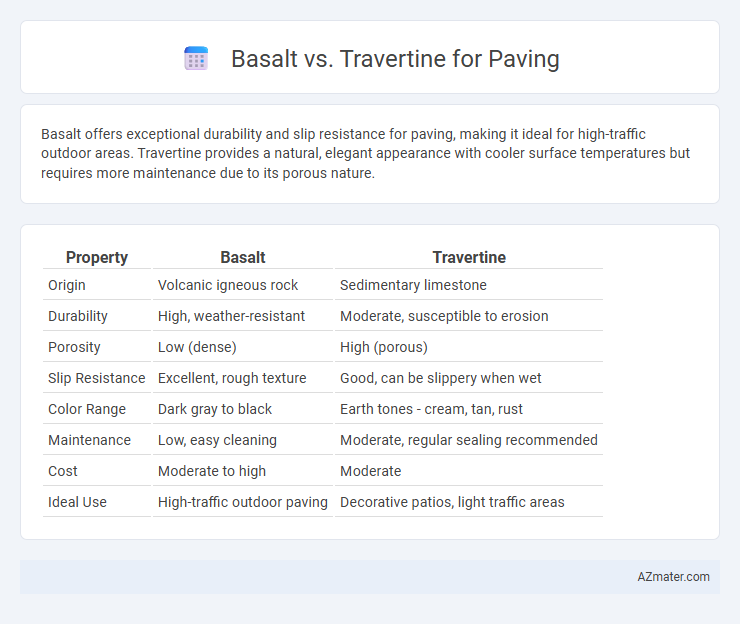Basalt offers exceptional durability and slip resistance for paving, making it ideal for high-traffic outdoor areas. Travertine provides a natural, elegant appearance with cooler surface temperatures but requires more maintenance due to its porous nature.
Table of Comparison
| Property | Basalt | Travertine |
|---|---|---|
| Origin | Volcanic igneous rock | Sedimentary limestone |
| Durability | High, weather-resistant | Moderate, susceptible to erosion |
| Porosity | Low (dense) | High (porous) |
| Slip Resistance | Excellent, rough texture | Good, can be slippery when wet |
| Color Range | Dark gray to black | Earth tones - cream, tan, rust |
| Maintenance | Low, easy cleaning | Moderate, regular sealing recommended |
| Cost | Moderate to high | Moderate |
| Ideal Use | High-traffic outdoor paving | Decorative patios, light traffic areas |
Introduction to Basalt and Travertine as Paving Materials
Basalt and travertine are popular natural stones used for paving due to their unique aesthetic and functional properties. Basalt, an igneous rock known for its durability and dark, fine-grained texture, offers exceptional resistance to weathering and heavy foot traffic. Travertine, a sedimentary limestone characterized by its porous surface and warm, earthy tones, provides a slip-resistant and visually appealing option for outdoor paving applications.
Formation and Geological Properties
Basalt forms from rapid cooling of lava at the Earth's surface, resulting in a dense, fine-grained igneous rock with high durability and low porosity, making it ideal for heavy-traffic paving applications. Travertine originates from the precipitation of calcium carbonate in hot springs or limestone caves, characterized by a porous, sedimentary texture and natural veining that offers aesthetic appeal but lower hardness compared to basalt. The geological composition of basalt provides superior resistance to weathering and abrasion, whereas travertine's calcium carbonate structure is more susceptible to acid erosion and requires sealing for outdoor paving durability.
Appearance and Color Variations
Basalt offers a sleek, modern appearance with a consistent dark gray to black color palette, ideal for creating bold, minimalist paving designs. Travertine features a warm, natural look with cream, beige, and tan tones that exhibit unique veining and pitted textures, providing a rustic and elegant aesthetic. The color variations in travertine are more diverse compared to basalt, making it suitable for designs emphasizing natural stone charm and subtle earth tones.
Durability and Weather Resistance
Basalt offers exceptional durability and weather resistance due to its dense, fine-grained volcanic origin, making it highly resistant to abrasion, frost, and moisture penetration. Travertine, a sedimentary limestone, provides moderate durability but is more porous and prone to weathering, requiring sealing to enhance its resilience against freeze-thaw cycles and staining. For paving applications exposed to harsh weather conditions, basalt generally outperforms travertine by maintaining structural integrity and aesthetic appeal over time.
Slip Resistance and Safety
Basalt offers superior slip resistance for paving due to its dense, rough texture, making it ideal for wet or high-traffic areas where safety is a priority. Travertine, while visually appealing with its porous surface, tends to be smoother and can become slippery when wet, requiring additional treatment to improve traction. Choosing basalt enhances safety with its natural grip, reducing the risk of slips and falls in outdoor paving applications.
Installation and Maintenance Requirements
Basalt offers high durability and low porosity, making it resistant to stains and requiring minimal sealing during installation, which simplifies maintenance over time. Travertine demands careful sealing and more frequent upkeep to prevent staining and weathering, with installation involving filling natural pits to create a smooth surface. Both materials benefit from professional installation to ensure longevity, but basalt's robustness generally results in lower long-term maintenance efforts compared to travertine.
Cost Comparison and Affordability
Basalt paving typically costs between $15 and $30 per square foot, making it a moderately priced option with high durability and resistance to weathering. Travertine ranges from $20 to $50 per square foot, reflecting its luxurious appearance and softer texture that may require more maintenance over time. While basalt offers better long-term affordability due to its low maintenance needs, travertine's cost is justified by its aesthetic appeal and natural variations favored in upscale landscaping projects.
Environmental Impact and Sustainability
Basalt paving offers superior environmental benefits due to its natural durability and low maintenance, reducing resource consumption over time compared to travertine. Travertine, being a sedimentary rock, often requires more intensive quarrying and processing, contributing to higher carbon emissions and ecological disturbance. Choosing basalt supports sustainability through its longevity and minimal ecological footprint, making it a preferable option for eco-conscious paving projects.
Best Applications for Basalt vs Travertine
Basalt, known for its durability and high resistance to weathering, is ideal for heavy-traffic outdoor paving such as driveways and commercial walkways. Travertine's porous surface and natural slip resistance make it a preferred choice for pool surrounds, patios, and shaded garden paths. While basalt excels under intense wear and climate variations, travertine offers aesthetic warmth and comfort suited for decorative, low-impact areas.
Choosing the Right Stone for Your Paving Project
Basalt offers exceptional durability and a dense, fine-grained texture ideal for high-traffic paving areas, while travertine provides a naturally porous surface with a warm, classic aesthetic suitable for patios and garden paths. When choosing the right stone for your paving project, consider basalt's resistance to weathering and minimal maintenance versus travertine's slip-resistant properties and timeless elegance. Understanding the specific environmental conditions and design preferences ensures selecting the optimal stone for long-lasting, visually appealing paving solutions.

Infographic: Basalt vs Travertine for Paving
 azmater.com
azmater.com